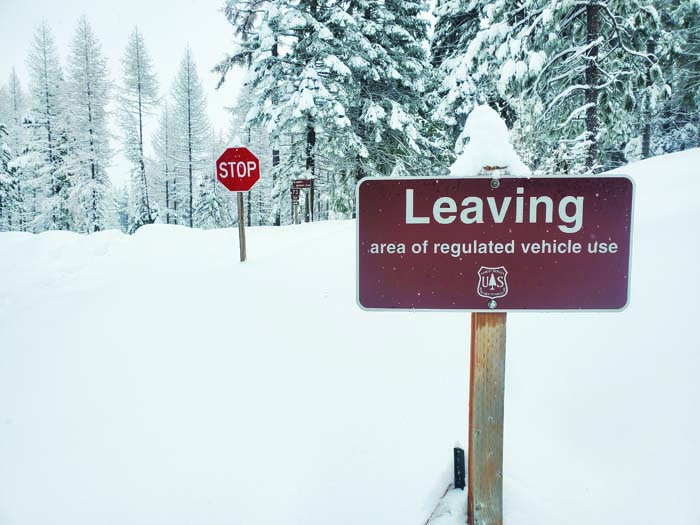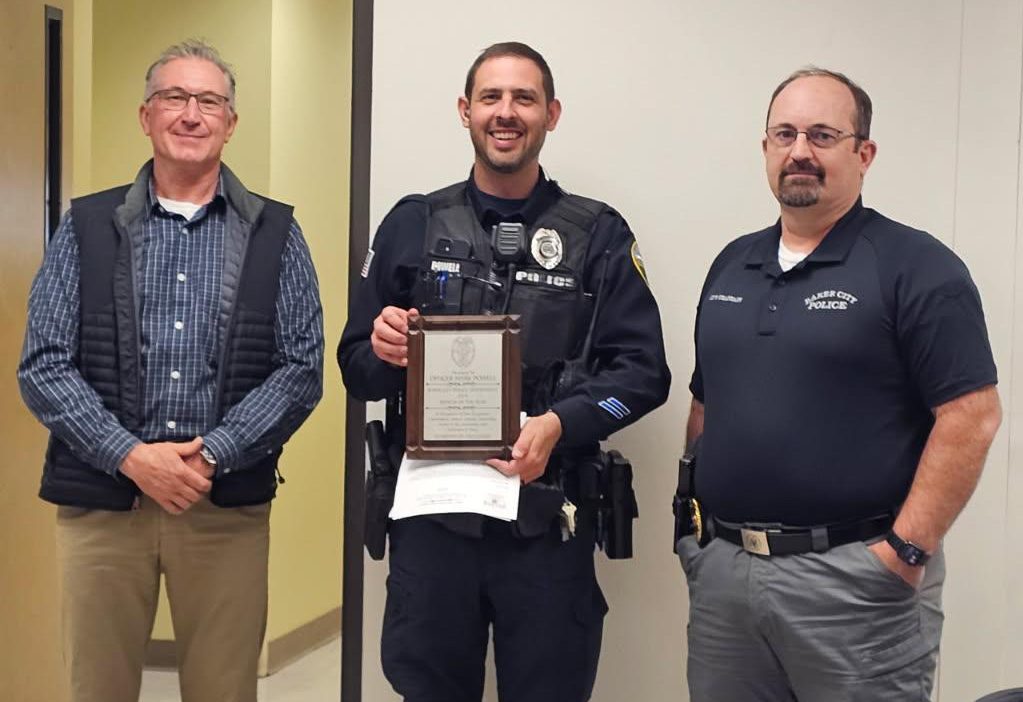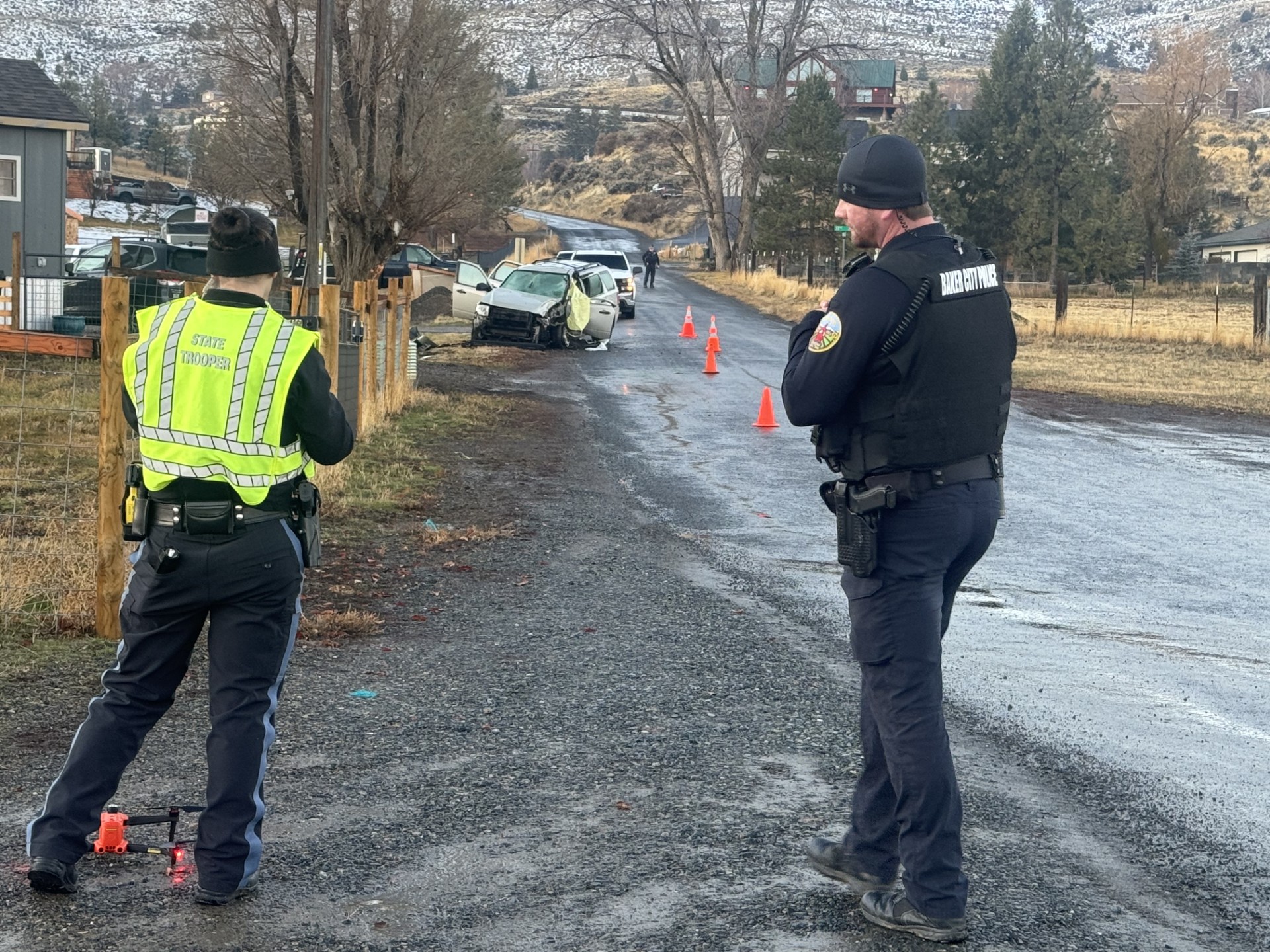Halting road closures: Some expanded closures listed in 2023 Big Game Regulations won’t happen this year
Published 12:45 pm Monday, January 9, 2023

- A sign at the junction of the 7312 Road and the Anthony Lakes Highway notes the boundary of a regulated closure area. Inside that area, roads that aren't marked with a green dot are closed to motor vehicles during part of the year, typically during the fall hunting seasons.
Hunters and other outdoor enthusiasts perusing the 2023 Big Game Regulations might have been surprised when they saw the significant expansion of road closures in Northeastern Oregon during archery and rifle hunting seasons later this year.
But that list, it turns out, is not final.
“Even though it’s printed, we do anticipate changes,” Nick Myatt, East Region manager for the Oregon Department of Fish and Wildlife (ODFW), said on Thursday, Jan. 5.At issue are Cooperative Travel Management Area closures, Myatt said.
These are widely known as “green dot” closures, as signs and maps use a green dot to designate which roads are open during the season. During that period all other roads in the designated area, those without a green dot, are closed to motor vehicles. One of the chief goals of the seasonal closures, Myatt said, is to reduce pressure on elk and deer, and to avoid pushing elk, in particular, from public land, where they’re accessible to hunters, onto private land, some of which is closed to hunting.
The seasonal closures, which ODFW adopts in cooperation with the Forest Service and other public land management agencies, started decades ago, and they’re generally not changed often, Myatt said. The list of changes proposed for 2023, and printed in the big game regulations, is one of the longest in recent years.
At least two of those changes definitely will not happen in 2023, Myatt said.
One involves the parts of Wallowa County’s Chesnimnus unit that are within the Wallowa-Whitman National Forest.
The 2023 regulations show that the seasonal motor vehicle closure in that area, which in the past has started three days prior to the first bull elk season when any legal weapon can be used, and continued through the end of the second season — roughly the first three weeks of November — would instead run for three months, from Aug. 20 through Nov. 20. The other area encompasses 100 square miles in the Imnaha unit, also in Wallowa County.
Currently, the road closures in that area run from three days prior to the first bull season through the close of the second bull season — again, mainly in the first three weeks or so of November.
The new closure would run from Aug. 20 through Dec. 1. One reason that neither the Chesnimnus nor Imnaha changes will take effect this year — and a reason that some other seasonal closures published in the regulations might not happen in 2023 — is the need to give the public another chance to express their opinions about the proposals, Myatt said.
“It’s a sensitive topic, and we want to make sure the public is aware of this and has a chance to comment,” he said.
Moreover, ODFW can’t unilaterally impose road closures, Myatt said.
For road closures on public land, the managing agency, typically the Forest Service or BLM, must also sign off on the closure or changes to the duration.
The Wallowa-Whitman National Forest, which manages much of the public land with green dot road closures in Northeastern Oregon, has not done so.
Anthony Botello, the Wallowa-Whitman’s deputy supervisor, wrote in an email to the Baker City Herald on Friday, Jan. 6 that forest officials are working with ODFW to review the green dot closures.
“While there may have been info released regarding changes, at this time, the restrictions and closure periods have not been changed from past years,” Botello wrote. “Changes to the closure dates or routes will not be implemented without engaging in public involvement before making any new decisions.”
That involvement includes giving the public a chance to comment, as well as coordinating with commissioners in affected counties, including Baker, Botello said in an interview on Friday, Jan. 6.
Botello said Wallowa-Whitman employees are trying to figure out which of the green dot closure changes the forest has already addressed, and solicited public comment about, through a project such as a timber sale.
He said there are some of those, but he doesn’t yet know how many. In those cases, or in ones when ODFW’s proposed change to a green dot closure is minor, extending a closure by a few days rather than a couple months or more, the change listed in the synopsis will take effect this year, he said.
Public participation
Although hunters are the primary audience for the big game regulations, Myatt pointed out that the seasonal road closures affect everyone who gets around in a motor vehicle.
Myatt said ODFW did solicit public comments about the proposed changes prior to the September 2022 meeting when the Fish and Wildlife Commission approved the slate of green dot closure changes.
He said the agency received relatively few responses, at least compared with the number of comments about such things as the proposed number of big game hunting tags.
Myatt said the difference doesn’t surprise him.
Setting the number of tags is something ODFW does every year, and it obviously has a major effect on hunters’ plans, so the topic garners quite a lot of attention.
But the agency only occasionally proposes significant changes to the green dot closures — the current list is the most wide-reaching in many years, Myatt said.
The comparative lack of public input to ODFW is a concern for Forest Service officials, Botello said. That also makes it imperative that forest users have a chance to weigh in through the Forest Service, he said.
Like Myatt, Botello noted that hunters are more likely to pay attention to green dot closures and be aware of the proposed changes compared with, say, people who gather firewood, pick mushrooms or huckleberries, or use the forest for other purposes.
“Public land users come in all shapes and sizes,” Botello said. “We want to make sure we cover all users.”
Botello said it probably would have been better, from a public awareness perspective, for ODFW to not have published the list of changes before the Wallowa-Whitman had completed a public comment process.
“The intent is not to take anyone by surprise,” he said.
Archery hunting drives proposed changes
A driving factor behind the proposed changes listed in the 2023 regulations is the major growth in the popularity of archery hunting for deer and elk, a month-long season that runs from late August through late September.
When most green dot closure areas were established, Myatt said, there were comparatively few archery hunters, with most hunters, and thus vehicle travel that can harass animals, concentrated in the rifle seasons in October and November.
As a result, the green dot closures generally started a few days before either the rifle buck or first rifle bull season, and continued through the end of the second bull season.
But with the proliferation of bowhunters, Myatt said, there is more pressure, from increased vehicle traffic, on elk and deer starting in late August.
That’s why the proposed change for many green dot areas in Northeastern Oregon shifts the start of the closure to Aug. 20, he said.
Hunter, county commissioner oppose proposed expansion of green dot closures
David Thiesfeld, a hunter from La Grande, considers ODFW’s proposal a “back door” effort to impose some of the road closures that the Wallowa-Whitman National Forest has proposed, through the Travel Management Plan process, but not yet imposed.
(The Wallowa-Whitman unveiled a plan in March 2012 that would have permanently, not seasonally, banned motor vehicle access on more than 3,000 miles of roads, but the agency withdrew that plan, following widespread complaints, about a month later. The Travel Management Plan is on hold until the Forest Service approves new management plans for all three forests in the Blue Mountains — Wallowa-Whitman, Umatilla and Malheur).
Thiesfeld testified remotely during the Fish and Wildlife Commission’s September meeting, expressing his opposition to the list of expanded closures that ended up being published in the 2023 regulations.
He feels his concerns have “fallen on deaf ears.”
Thiesfeld contends that some archery hunters exaggerate how much they hunt, which results in ODFW overestimating how much pressure archery hunters are putting on big game herds.
He worries that if green dot closures are in effect during archery season, more animals killed by archers will be wasted because hunters, without the ability to use motor vehicles to retrieve their animals, will lose the meat to spoiling during the warm late summer weather.
“Unless you have a group of people that are willing to come in and help you pack your animal out, it’s more than likely to spoil before you can get it out,” Thiesfeld said.
The road closures also affect hunters who aren’t physically capable of covering large distances without a motor vehicle.
Thiesfield said he suggested the state include exceptions to the green dot closures, such as having one day before each major hunting season when hunters could use vehicles to move in their camps, or allowing hunters to use vehicles for a limited period late in each day when they could retrieve a kill.
Christina Witham, who was sworn in last week as a Baker County commissioner, also has concerns about the effects of ODFW’s proposed expansion of green dot road closures. Witham, who said recently that preserving access to public lands, including by motor vehicles, is one of her priorities as a commissioner, said she talked with a Wallowa-Whitman employee who was surprised by the list of longer closures published in the big game regulations.
Witham said she and Doni Bruland, the county’s natural resources coordinator, are researching the issue, including any agreements between ODFW and the Forest Service regarding green dot closures. Witham said on Thursday, Jan. 5 that she worries that the publication of the new green dot closure schedule in the 2023 regulations, even though the schedule will be changed, will confuse hunters as they plan for their hunts later this year.
“I think (ODFW) jumped the gun,” Witham said.
Following are examples of proposed expansions to seasonal motor vehicle closures (green dot closures) in Northeastern Oregon.
Sumpter unit: Dark Canyon
• Current closure: 3 days prior to opening of buck season through close of last elk season — late September through mid November.
• Proposed closure: Aug. 20 through Nov. 20.
Sumpter unit: Patrick Creek
• Current closure: 3 days prior to opening of buck season through close of last elk season — late September through mid November — and May 1 through June 30.
• Proposed closure: Aug. 20 through Nov. 20, and May 1 through June 30.
Starkey unit: Trail Creek
• Current closure: 3 days prior to first bull season through close of second bull season, late October through mid November.
• Proposed closure: Aug. 20 through Nov. 20.
Starkey unit: Indian Creek-Gorham Butte
• Current closure: 3 days prior to first bull season through close of second bull season, late October through mid November.
• Proposed closure: Aug. 20 through Nov. 20.
Catherine Creek unit: Little Catherine Creek
• Current closure: 3 days prior to archery season (late August) through May 31.
• Proposed closure: Permanent, year round.
Sled Springs unit: Noregaard, Shamrock, Whiskey Creek
• Current closure: 3 days prior to archery season (late August) through May 31.
• Proposed closure: Permanent, year round.
Chesnimnus unit: portion of unit on Wallowa-Whitman National Forest
• Current closure: 3 days prior to first bull season through end of second bull season, roughly first three weeks of November.
• Proposed closure: Aug. 20 through Nov. 20.





